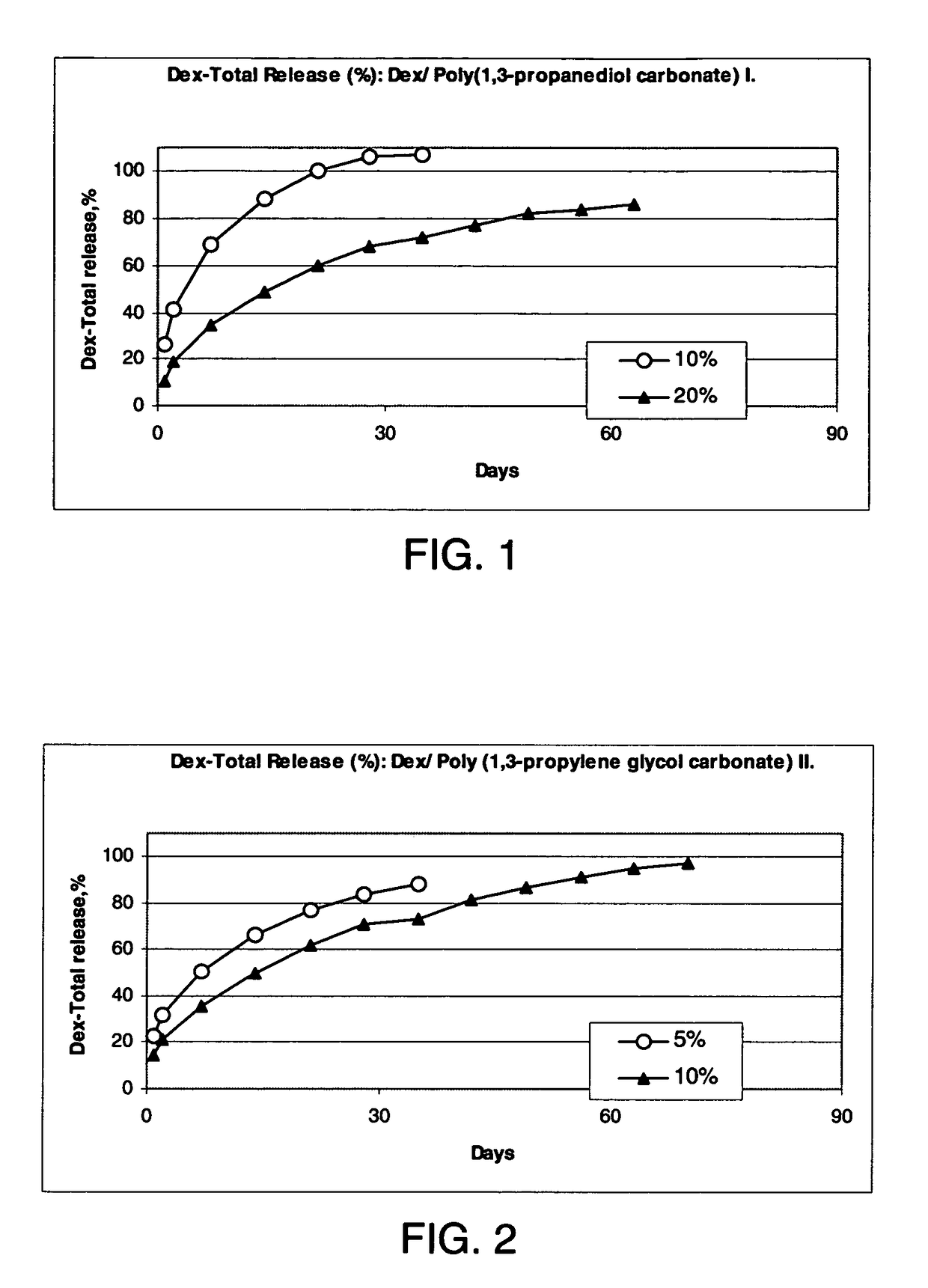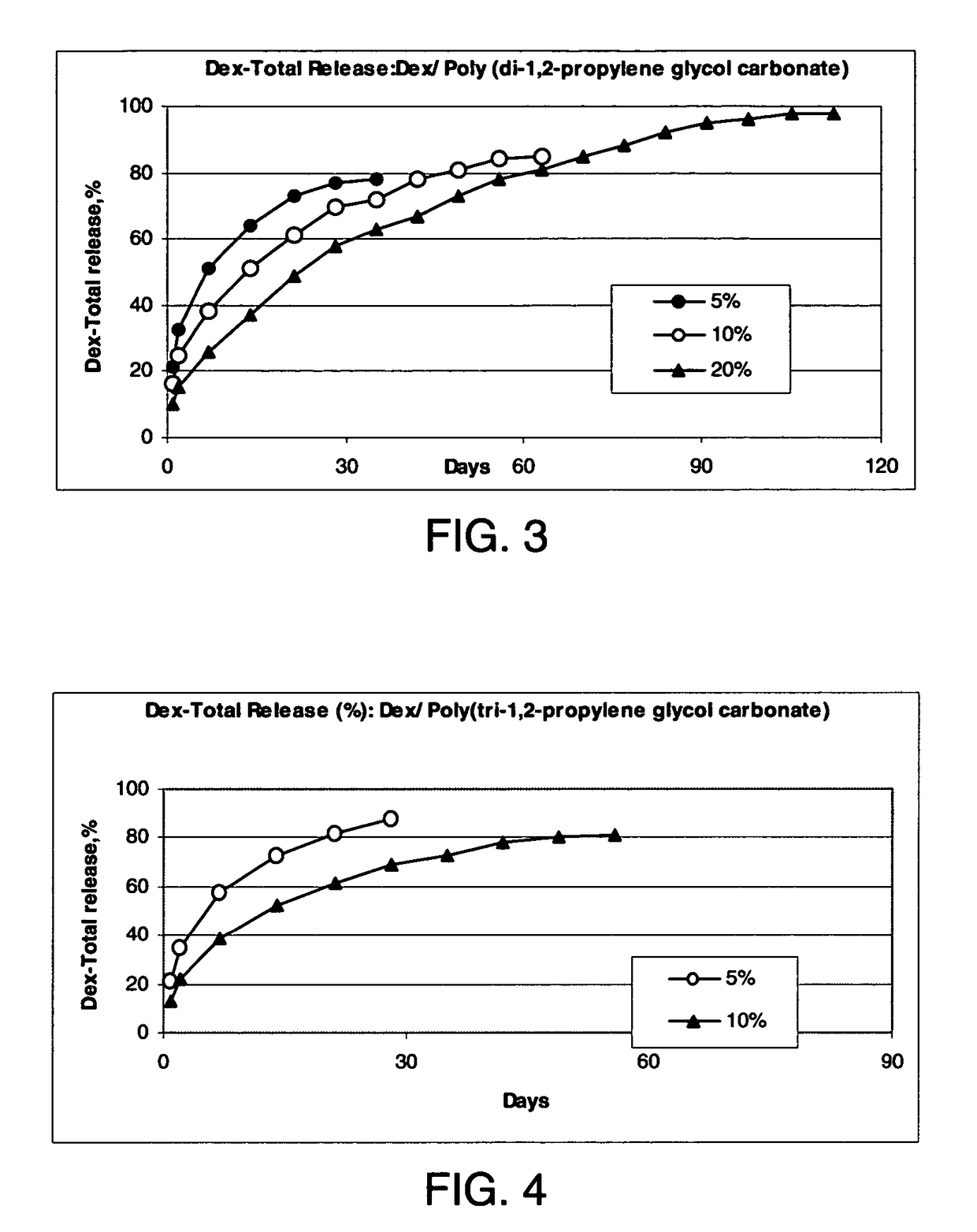Conveniently implantable sustained release drug compositions
a drug composition and sustained release technology, applied in the field of biocompatible and biodegradable syringeable liquid, implantable solid, injectable gel pharmaceutical formulations, to achieve the effects of convenient, convenient and efficient drug delivery system, easy production, and convenient manipulation and injection or implanting
- Summary
- Abstract
- Description
- Claims
- Application Information
AI Technical Summary
Benefits of technology
Problems solved by technology
Method used
Image
Examples
example 1
Preparation of a Poly(1,3-propanediol carbonate) I from 1,3-propanediol at 65° C. and 96 Hours
[0216]To 23.6 g (0.2 mole) diethyl carbonate (b.p. 128° C.) was added 15.2 g (0.2 mole) 1,3-propanediol containing 0.05 g (1.25 mmole) of metallic Na to give two liquid phases. These reactants were placed in an open container in a 65° C. oven and were shaken occasionally. After 12 hours, the reactants were a homogeneous solution weighing 38.0 g. The theoretical weight for the loss of 0.4 moles (18.4 g) of ethanol in a complete reaction would be 20.4 g. The heating and occasional shaking were continued to give 27.0 g at 24 hours, 23.2 g at 48 hours, 21.4 g at 72 hours, and 17.4 g at 96 hours. The product oil was washed with 15 ml 5% aqueous acetic acid to two phases. The top phase was the water soluble phase. The 10.5 ml bottom phase was washed with 15 ml water to give 7.5 ml of a poly(1,3-propylene glycol carbonate) oligomer as a water-insoluble oil.
example 2
Preparation of Poly(1,3-propanediol carbonate) II from 1,3-propanediol at 110-150° C. and 26 Hours
[0217]A mixture of 76 g (1.0 mole) 1,3-propanediol containing 0.1 g metallic Na (2.5 mmole) and 118 g (1.0 mole) diethyl carbonate was heated at 110° C. As soon as the reactants reached 60° C. they formed a homogeneous solution. After heating 8 hours, the reactants had lost 48 g (52% of theoretical amount of ethanol). The temperature was then raised to 150° C. After 10 hours, the reactants lost another 46 g. A drop of this product completely dissolved in water. The resultant 97 g of oil was mixed with 6 g (0.05 moles) diethyl carbonate and the resultant solution was heated with occasional stirring at 150° C.
[0218]After 8 hours, the resultant syrup was found to be partially insoluble in water. The product was washed with 100 ml 5% aqueous acetic acid followed by four washings with 100 ml portions of water to give 46.1 g slightly yellow viscous oil (46.1 / 102=45% yield).
example 3
Preparation of a Poly(di-1,2-propylene glycol carbonate) from di-1,2-propylene glycol
[0219]To 59.0 g (0.5 moles) diethyl carbonate was added 67.0 g (0.5 moles) di-1,2-propylene glycol which had been reacted with 0.02 g Na to form a homogeneous solution. The reactants were placed in an open flask at 100° C. After 12 hours, the solution lost 23.4 g (about 50% of the theoretical 46 g ethanol). After another 15 hours at 150° C. the reactants had lost a total of 53.2 g to give a syrup that was partially insoluble in water. The product was washed with 100 ml 5% aqueous acetic acid followed by four washing with 100 ml portions of water to give 25.2 g colorless viscous, water insoluble liquid poly(di-1,2-propylene glycol carbonate) oligomer.
PUM
| Property | Measurement | Unit |
|---|---|---|
| concentrations | aaaaa | aaaaa |
| concentrations | aaaaa | aaaaa |
| concentration | aaaaa | aaaaa |
Abstract
Description
Claims
Application Information
 Login to View More
Login to View More - R&D
- Intellectual Property
- Life Sciences
- Materials
- Tech Scout
- Unparalleled Data Quality
- Higher Quality Content
- 60% Fewer Hallucinations
Browse by: Latest US Patents, China's latest patents, Technical Efficacy Thesaurus, Application Domain, Technology Topic, Popular Technical Reports.
© 2025 PatSnap. All rights reserved.Legal|Privacy policy|Modern Slavery Act Transparency Statement|Sitemap|About US| Contact US: help@patsnap.com



